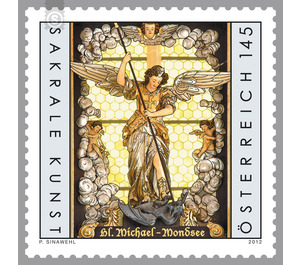Sacred art - Austria / II. Republic of Austria 2012 - 145 Euro Cent
Theme: Art & Culture
| Country | Austria / II. Republic of Austria |
| Issue Date | 2012 |
| Face Value | 145.00 |
| Edition Issued | 270,000 |
| Printing Type | combination printing |
| Stamp Type | Commemorative |
| Item Type | Stamp |
| Chronological Issue Number | 2358 |
| Chronological Chapter | OOS-OE2 |
| SID | 912175 |
| In 63 Wishlists | |
With a detailed picture of the high altar of the Mondseer Basilika zum Heiligen Michael, the popular series "Sacral Art in Austria" now finds its attractive continuation. The 18-meter-high, early Baroque high altar is dated to the year 1626 and comes from the sculptor Hans Waldburger. Born in Innsbruck in 1571 as the son of the court sculptor Leonhard Waldburger and called to Salzburg by Archbishop Wolf Dietrich, he worked for the monasteries of St. Peter and Nonnberg. The high altar of the Basilica Mondsee, however, is the only surviving altarpiece Waldburgers; It was the prelude to the artistic renewal of the collegiate church after the turmoil of the Reformation. The black and gold retable in the scheme of a triumphal arch altar stands in the choir's head in front of the middle choir window. The tabernacle rising above the altar table is surrounded by a huge, seven-part reliquary tower, whose richly decorated shrines were gradually filled with special relics from 1731 to the millennium in 1748 - thus one of the largest relics altars in Austria was created in Mondsee. It contains in the middle raised the bones of Blessed Abbot Konrad II, whose skeleton was put together in 1732 to a seated figure, as well as on the sides of the lying skeletons of four catacomb saints. The dominant plastic central scene shows the coronation of Mary by the Holy Trinity, whose witnesses are the saints Benedict and Wolfgang. The Coronation of the Virgin is flanked by the apostle princes Peter and Paul in the side shellfish tables, above which are hung two high-rectangular panels depicting the Annunciation. The outer sculptures represent the Agilofinger Duke Odilo II and his son Tassilo III. The center of the excerpt is the figure of the Archangel Michael, flanked by Saints Stephen and Laurentius. The altar situation in the choir is complemented by the liturgical places Volksaltar, Ambo and Vorstehersitz, an ensemble characterized by simplicity and balance, which was created in 2008 by the South Tyrolean artist Lois Anvidalfarei for the basilica. The sanctuary of the Basilica Minor also found its place in the sanctuary: the yellow-red striped Conopeum (originally a protective shield for the Holy of Holies in processions) and the Tintinnabulum (a bible also from the procession on a lectern). Hans Waldburger created numerous works in Salzburg - among the most important are the Susannabrunnen in the Kurpark, several garden figures in Hellbrunn Palace, the organ of St. Peter, the organ case of the parish church of St. Wolfgang and the former high altar of Nonnberg Abbey.


